Creating a sustainable lifestyle has become a crucial goal for many individuals seeking to reduce their impact on the environment. Among the various strategies to achieve this, adopting a zero-waste lifestyle stands out as a compelling and actionable path.
Zero waste rules encourage individuals and businesses to reduce, reuse, and recycle materials to divert them from landfills. Key principles include refusing single-use items, embracing composting, and prioritizing products with minimal packaging.
In this blog post, we’ll take a closer look into the foundational principles of the zero waste movement, offering clear, actionable rules that anyone can incorporate into their daily life. Whether you’re a seasoned eco-warrior or a newcomer to the concept of sustainable living, these guidelines will help you make meaningful changes that benefit both the planet and your personal well-being.
How to Start Your Zero Waste Journey
Starting a zero waste journey is a commendable decision that can lead to a more sustainable lifestyle, reducing your environmental footprint and contributing to a healthier planet.
Here’s a step-by-step guide to help you embark on this rewarding path.
Conducting a Waste Audit
The initial step on your zero waste journey is conducting a waste audit, which is crucial for understanding the specifics of your personal waste production. This process involves collecting all your waste for a set period, such as a week, and then sorting it into categories like plastics, paper, food scraps, etc.
The purpose is to identify the biggest contributors to your waste stream. By analyzing these categories, you can recognize which items were unnecessary, could have been replaced with reusable alternatives, or avoided altogether.
If you’re having a hard time getting started, here’s a step-by-step guide:
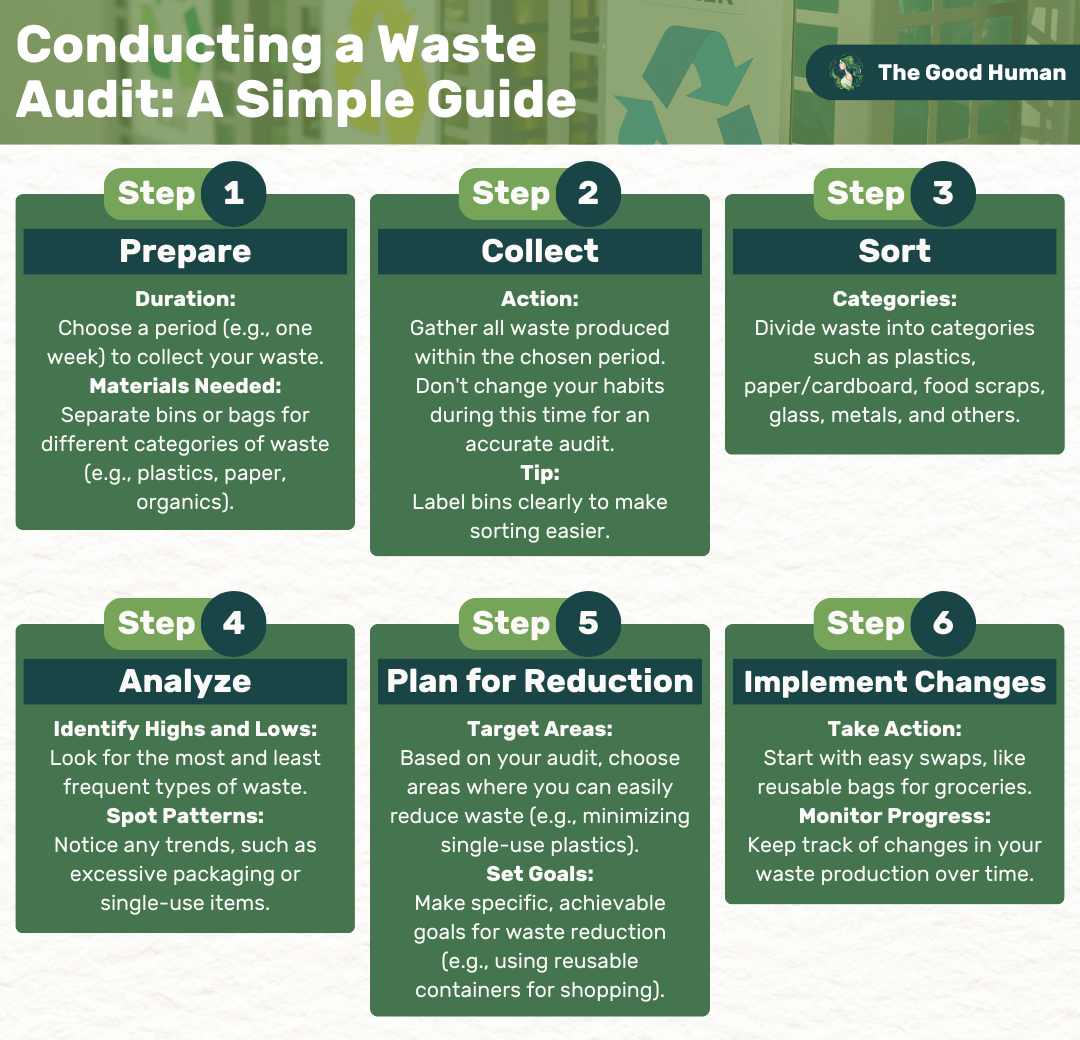
Setting Realistic Zero Waste Goals
After understanding your waste habits, the next step is setting realistic zero waste goals. Transitioning to a zero waste lifestyle is more of a marathon than a sprint, requiring sustainable, achievable changes over time.
Begin by focusing on one area where you can make a significant impact, such as reducing single-use plastics in your kitchen. Goals should be specific and measurable to allow for tracking progress and making adjustments as needed.
For instance, instead of a broad objective like “reduce waste,” set a clear target like “bring reusable bags and containers for all grocery shopping” or “use reusable produce bags for fruits and vegetables.”
This approach ensures your goals are tangible and attainable, paving the way for gradual, impactful changes in your lifestyle.
Essential Zero Waste Products and Alternatives
Identifying and integrating essential zero waste products and alternatives into your daily routine is a fundamental aspect of this journey. Start by replacing commonly used disposable items with sustainable alternatives.
For instance, switch from single-use plastic water bottles to a durable stainless steel or glass water bottle. Instead of disposable plastic bags, opt for reusable produce bags and shopping totes.
For personal care, consider bar soaps and shampoos, bamboo toothbrushes, and refillable dental floss. In the kitchen, beeswax wraps can replace cling film, and silicone baking mats can take the place of parchment paper. Each of these swaps not only reduces waste but also often results in savings over time, as many reusable items last significantly longer than their disposable counterparts.
The key is to focus on gradual changes, integrating new products as needed, and always seeking out sustainable alternatives that fit your lifestyle.
Zero Waste Rules for Everyday Life
Adopting zero waste rules into everyday life involves making conscious decisions in various aspects of our daily routines, from the kitchen to the wardrobe. Implementing these practices can significantly reduce our environmental footprint and support a more sustainable lifestyle.
Kitchen
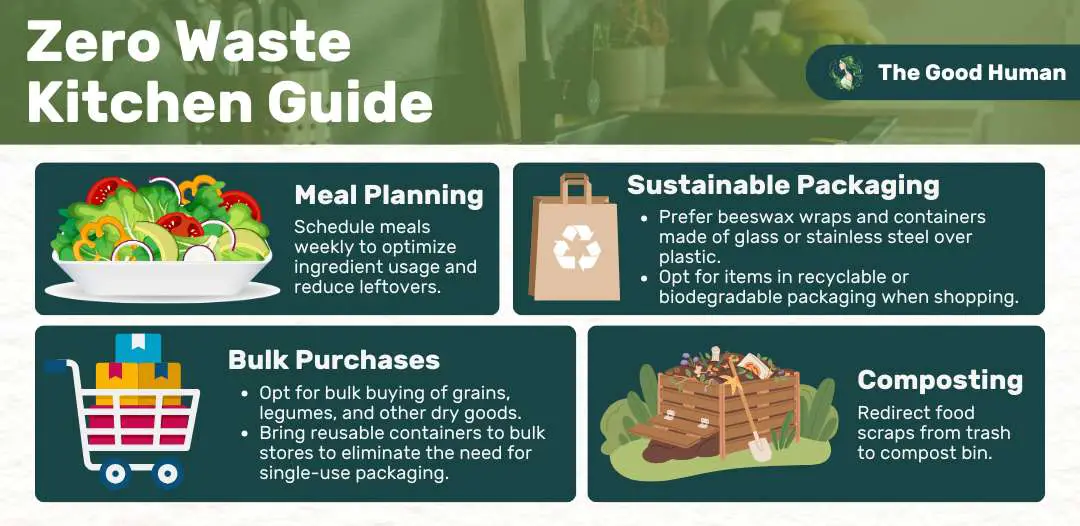
Meal planning is a cornerstone of a zero waste kitchen. By planning meals in advance, you can avoid unnecessary purchases and reduce food waste.
Bulk buying, particularly for dry goods like grains and legumes, minimizes packaging waste. Shopping at stores that offer food in bulk and using your own containers can dramatically cut down on single-use packaging.
Instead of discarding food scraps into the trash, composting them turns this “waste” into a resource. Composting food scraps not only reduces the amount of waste sent to landfills but also provides nutrient-rich soil for sustainable gardening, completing a natural cycle that benefits both your garden and the environment.
Opting for eco-friendly packaging alternatives is another key practice. This includes using beeswax wraps instead of plastic cling film, storing leftovers in glass or stainless steel containers, and choosing products packaged in recyclable or compostable materials whenever possible.
Bathroom
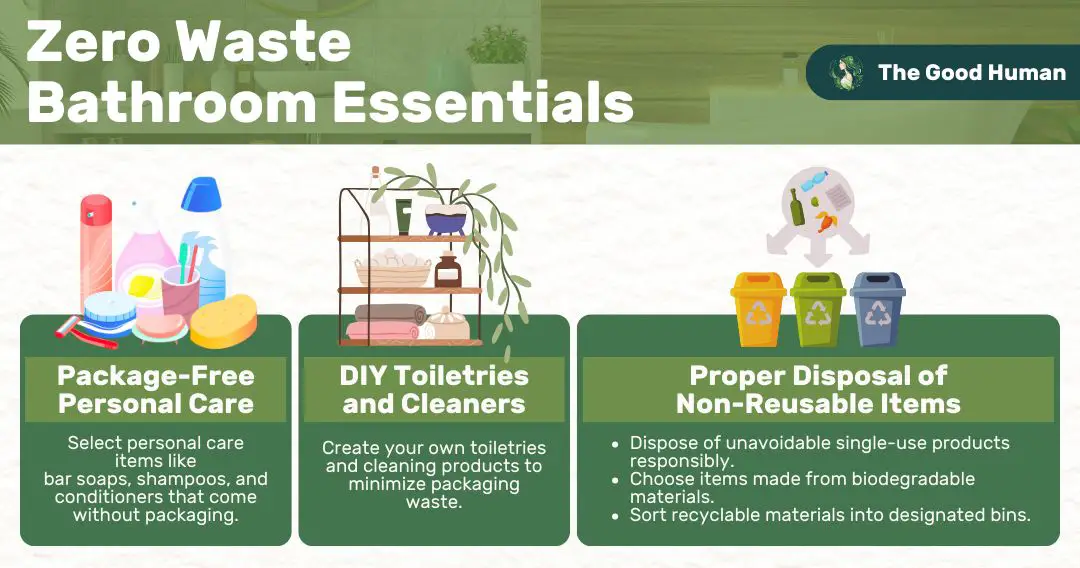
The bathroom is another area where zero waste efforts can make a significant impact. Choosing package-free personal care products, such as bar soaps, shampoos, and conditioners, reduces plastic waste. Many brands now offer solid versions of these products, which come with minimal or no packaging.
Making your own toiletries and cleaning products not only cuts down on packaging waste but also allows you to control the ingredients, avoiding harmful chemicals. Recipes for homemade toothpaste, deodorants, and all-purpose cleaners are widely available and often use simple, natural ingredients.
For items that cannot be replaced with reusable alternatives, such as certain hygiene products, it’s important to dispose of them properly. This can include choosing products made from biodegradable materials or using designated bins for recyclable materials.
Wardrobe
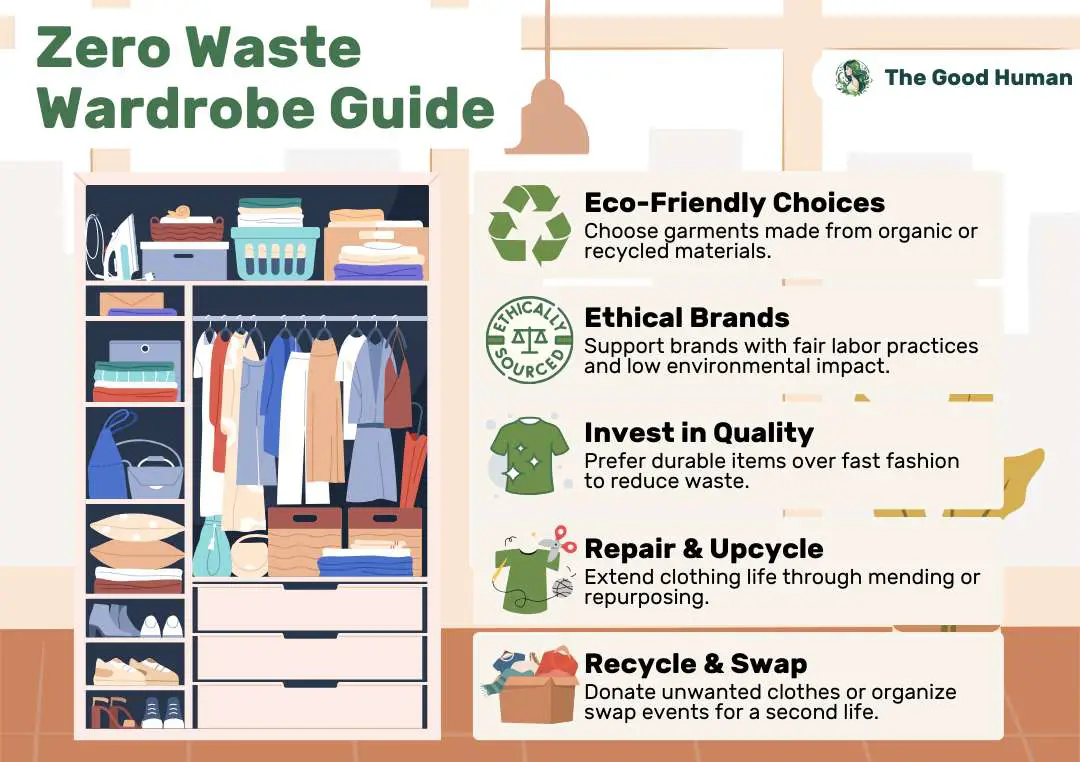
Making sustainable fashion choices involves opting for clothing made from eco-friendly materials, supporting brands that practice ethical production methods, and considering the longevity of garments before purchasing. This approach encourages a move away from fast fashion towards a more conscious wardrobe.
Repairing and upcycling clothes extend their life and reduce the need for new purchases. Learning basic sewing skills to mend torn garments or transform old clothing into new pieces can significantly reduce textile waste.
Instead of throwing away clothes that no longer fit or are no longer wanted, donating them to charity or organizing clothes swapping events with friends or community groups can give them a second life.
Household
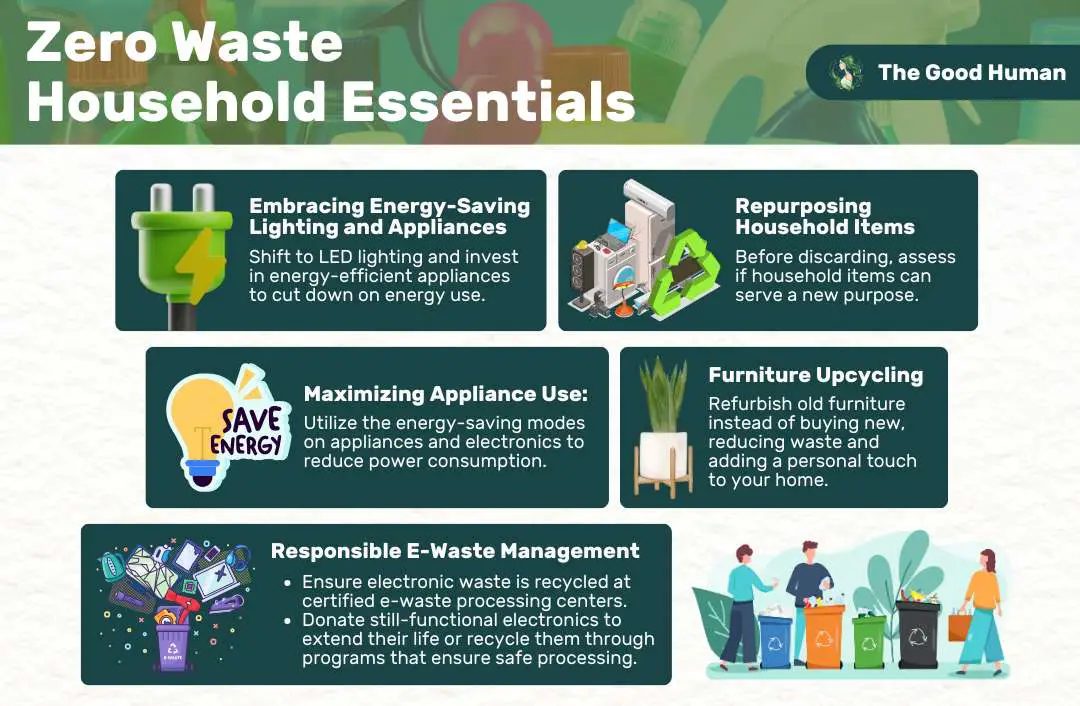
Reducing energy consumption in the household not only saves money but also lessens your carbon footprint. This can include simple changes like switching to LED light bulbs, using energy-efficient appliances, and being mindful of water usage.
Before disposing of household items, consider whether they can be repurposed. Old jars can become storage containers, and worn-out towels can be cut into cleaning rags. This practice not only reduces waste but also fosters creativity in finding new uses for old items.
Electronic waste (e-waste) is a rapidly growing issue. Disposing of electronics responsibly means recycling them at designated e-waste facilities where they can be properly processed, preventing harmful chemicals from contaminating the environment.
Zero Waste Rules in Community and Workplace
Embracing zero waste rules extends beyond individual efforts, involving collective action within communities and workplaces. By fostering environments that prioritize sustainability, we can amplify the impact of zero waste initiatives.
Advocacy and Education
One effective way to promote zero waste principles is by organizing workshops in both community and workplace settings. These workshops can cover various topics, such as the basics of starting a zero waste lifestyle, how to compost at home, or DIY projects to reduce waste. By educating others, we can inspire action and facilitate a collective shift towards sustainability.
Advocacy also involves encouraging sustainable practices within the broader community. This can be achieved through various means, such as initiating community clean-up events, establishing community gardens, or advocating for local policies that support waste reduction and recycling programs.
By fostering a culture of sustainability, communities can work together to create a more environmentally friendly living environment.
Corporate Sustainability
In the workplace, companies can take a leading role in sustainability by implementing zero waste policies. This might involve setting goals to minimize waste production, improving recycling and composting facilities, or investing in sustainable infrastructure.
By adopting these practices, businesses not only contribute to environmental preservation but also often realize cost savings through more efficient resource use.
A key area of focus for corporate sustainability is reducing the use of single-use plastics. Companies can achieve this by providing employees with reusable alternatives, such as water bottles, coffee cups, and cutlery, and by eliminating disposable plastics from cafeterias and vending machines. This shift not only reduces waste but also sets a positive example for employees and visitors.
Collaboration and Networking
Individual and corporate efforts can be significantly enhanced through collaboration and networking. Joining local zero waste groups or online communities provides opportunities to share knowledge, exchange ideas, and support one another’s initiatives. These networks can serve as valuable resources for learning about new zero waste practices and staying motivated.
Forming partnerships with local businesses can lead to impactful waste reduction initiatives. For example, workplaces can collaborate with local cafes to encourage the use of reusable cups or partner with food suppliers to reduce packaging waste. These partnerships not only help to reduce waste but also strengthen community ties and support the local economy.
Zero waste rules in the community and workplace are about building a collective ethos of sustainability. Through advocacy, corporate responsibility, collaboration, and networking, we can create environments that support and promote zero waste lifestyles. These collective efforts are crucial for making significant strides towards a more sustainable and waste-free world.
Overcoming Challenges and Roadblocks
Embarking on a zero waste journey is both rewarding and challenging. Individuals often encounter obstacles related to convenience, cost, and accessibility. Recognizing and addressing these challenges is crucial for sustaining a zero waste lifestyle over the long term.
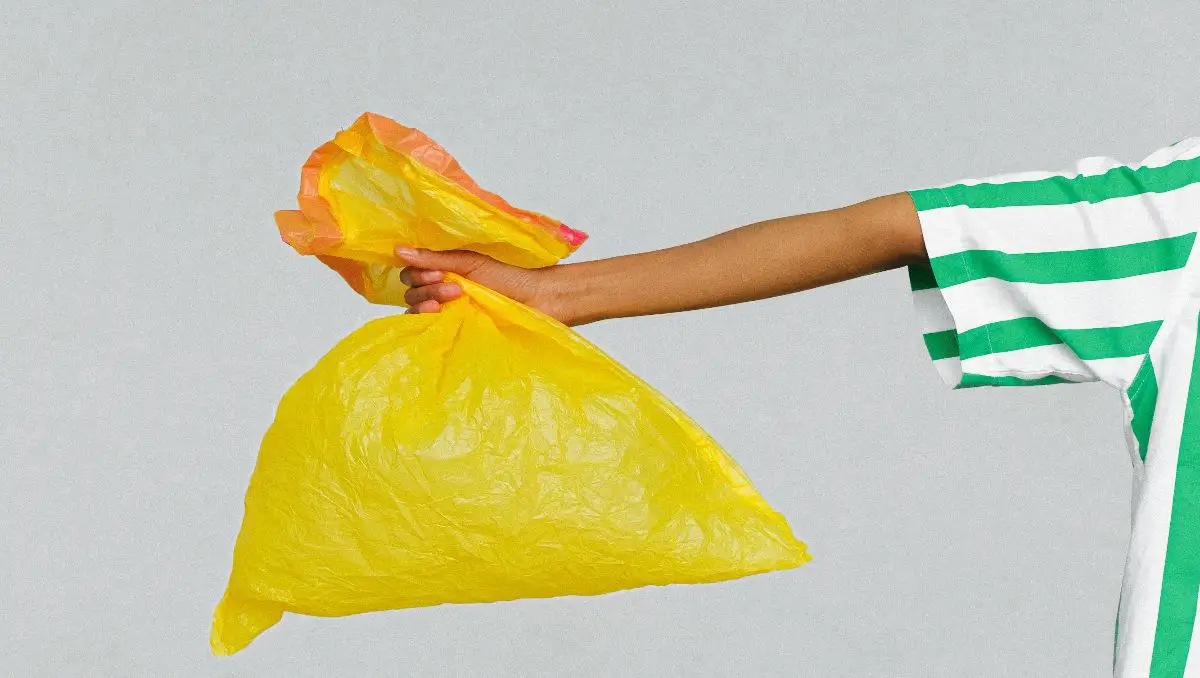
Dealing with Non-Compostable or Recyclable Materials
One of the trickier aspects of zero waste living is managing items that cannot be composted or recycled. For such materials, the first step is to minimize their use as much as possible.
However, when they do enter our lives, creative solutions are needed. Researching local waste management policies is crucial, as some areas offer special recycling programs for items like electronics, batteries, and certain types of plastic.
For truly non-recyclable items, consider repurposing where possible. For instance, old clothing that can’t be donated might be turned into rags for cleaning. Engaging with zero waste communities online can also provide innovative ideas for repurposing or responsibly disposing of challenging materials.
Convenience
One of the most significant barriers to zero waste living is the convenience of disposable items. Our fast-paced lifestyle has made single-use products almost indispensable. To overcome this challenge, planning and preparation are key.
Investing in reusable alternatives, such as water bottles, coffee cups, and shopping bags, can make it easier to avoid disposables. Keeping these items handy in your car, office, or bag ensures you’re prepared no matter where you go. Additionally, dedicating a little extra time each week to meal prep using bulk-purchased ingredients can reduce the need for packaged foods.
Cost
The initial cost of sustainable products can also be a deterrent. While reusable items often come with a higher upfront cost, they save money in the long run. To mitigate these costs, start small; you don’t need to buy everything at once.
Focus on items that you’ll use frequently to maximize the return on your investment. Look for second-hand options for items like glass containers or clothes. Also, many DIY solutions, such as homemade cleaning products, are not only cheaper but also reduce waste.
Accessibility
Access to bulk stores, farmers’ markets, and zero waste shops can be limited, depending on where you live. This can make it challenging to find unpackaged goods. To navigate this, try to maximize the resources you do have access to.
Purchase fruits and vegetables without plastic packaging from regular supermarkets, or join a community-supported agriculture (CSA) program. Online resources and shops also offer bulk items and sustainable goods that can be delivered to your doorstep.
For those living in areas with more severe limitations, focusing on reducing waste in other ways—such as reducing energy consumption or advocating for local waste reduction policies—can still have a significant impact.
Handling Social Pressures and Skepticism
As previously discussed, handling social pressures and skepticism involves patience, understanding, and leading by example. Sharing your journey and the positive impacts of your choices can inspire curiosity and change. It’s also helpful to find and engage with a supportive community, whether online or in-person, to share experiences and strategies for navigating social dynamics related to sustainability.
Budget-Friendly Zero Waste Solutions
Contrary to some perceptions, zero waste living can be economical. The key to budget-friendly zero waste solutions is focusing on reducing consumption and making the most of what you already have. Buying second-hand, choosing quality items that last longer, and DIY projects are all ways to save money while reducing waste.
Bulk buying, growing your own food, and making homemade cleaning or personal care products can also significantly cut costs. Remember, the essence of zero waste is not about buying a multitude of eco-friendly products but rather minimizing need and waste.
Overcoming Convenience Culture
The convenience culture, with its emphasis on single-use items and on-demand services, presents a significant barrier to zero waste living.
To overcome this, planning and preparation are vital. Carrying reusable items like water bottles, coffee cups, and shopping bags ensures you’re prepared to refuse single-use plastics. Meal prepping can reduce the temptation for takeout, and creating a zero waste kit for your car or office can help you stick to your goals even when on the go.
Embracing a mindset of mindfulness about consumption and taking the time to consider the lifecycle of the products we use can also shift perspectives away from the need for convenience.
Are You On The Right Track? How to Assess Your Progress
As you navigate the complexities of zero waste living, it’s essential to periodically assess your progress. This not only helps you stay motivated but also allows you to identify areas for improvement.
Here’s how you can evaluate your journey towards a more sustainable lifestyle.
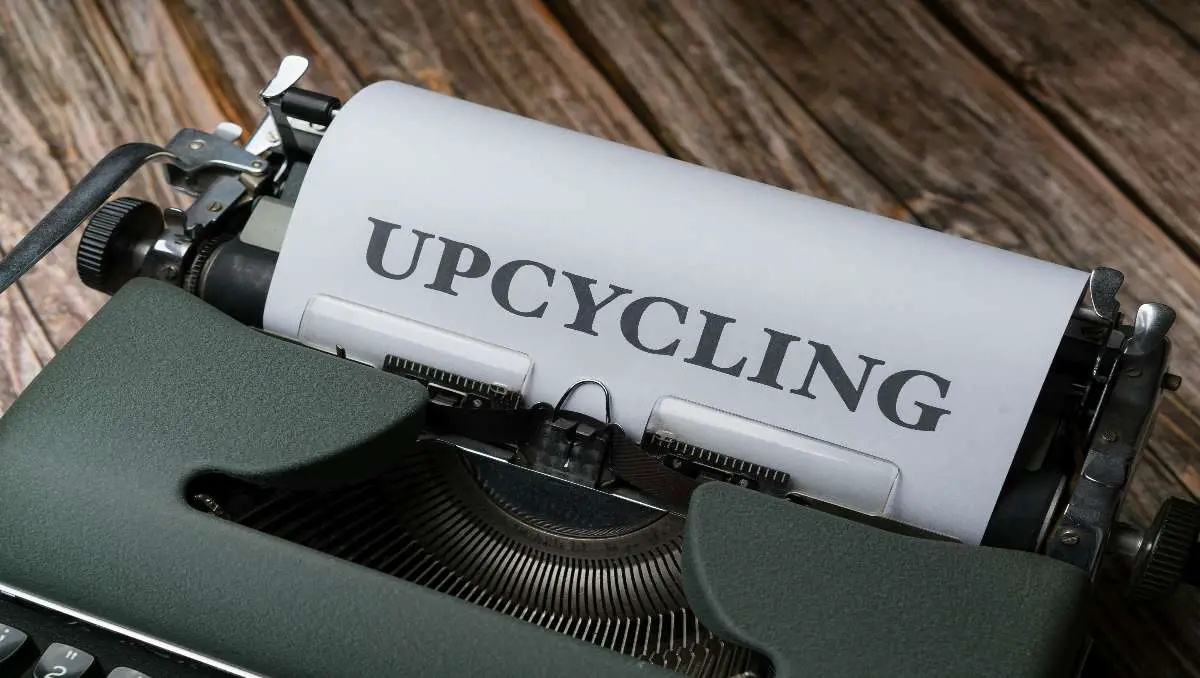
Track Your Waste Reduction
One of the most tangible ways to assess progress is by tracking the amount and type of waste you produce. Start by conducting regular waste audits—similar to the initial audit you might have done at the beginning of your journey. Compare the volume and type of waste you generate over time.
You should be able to see a reduction in the amount of trash and possibly an increase in recyclables and compostables. Documenting this progress, perhaps through a journal or a digital spreadsheet, can provide a clear visual representation of how far you’ve come.
Set and Review Goals
Setting specific, measurable goals is crucial for any zero waste journey. Periodically review these goals to assess which ones you’ve achieved, which are ongoing, and if there are new ones to set. Goals can range from reducing single-use plastics in your household to achieving a certain amount of waste-free days per month. Celebrating these milestones can boost your motivation and commitment.
Reflect on Lifestyle Changes
Assessing your progress isn’t just about the physical waste you’ve reduced; it’s also about reflecting on the changes in your lifestyle and mindset. Consider how your shopping habits, consumption patterns, and overall lifestyle have shifted since you started.
Are you making more conscious decisions about purchases? Have you adopted new habits that align with zero waste principles, such as carrying reusable items or choosing to repair rather than replace? These changes are significant markers of progress.
Evaluate the Financial Impact
Zero waste living often has the added benefit of saving money in the long run. Evaluate how your financial situation has been impacted by your zero waste efforts. This could be through savings from buying less, choosing reusable items over disposable ones, or making your own products. Assessing the financial impact can provide a practical incentive to continue and deepen your zero waste practices.
Adjust and Set New Challenges
Finally, assessing your progress is an opportunity to adjust your approach and set new challenges. Zero waste living is a dynamic process; what worked at one stage may need to be adapted as your situation changes. Setting new challenges keeps the journey interesting and ensures continuous improvement.
You might be interested in exploring the 5 R’s of zero-waste living.
Final Thoughts
Embarking on a zero waste journey is a profound commitment to living more sustainably, reducing our environmental footprint, and fostering a healthier planet for future generations.
The journey towards zero waste is not without its challenges, yet it is filled with opportunities for personal growth, community building, and significant environmental impact. It’s a path that encourages us to rethink our consumption habits, make more conscious choices, and inspire others to consider their environmental footprint. By assessing our progress and continuously striving for improvement, we can stay motivated and recognize the tangible difference our efforts make.







